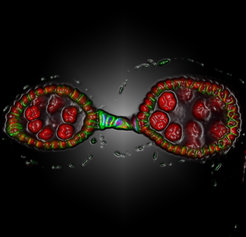From famine to feast: Cells can adapt to nutritional changes
Max Planck researchers reveal that microRNAs help cells react to variable nutrient supply
miRNAs are tiny RNA shreds that control the activity of genes. Each miRNA can affect many genes and, conversely, one gene can be controlled by multiple miRNAs. Thus, miRNAs simultaneously fine-tune multiple facets of the cell’s machinery.

With her team, Halyna Shcherbata, head of the Max Planck Research Group Gene Expression and Signaling at the MPI for Biophysical Chemistry, investigated the role of a particular set of miRNAs in the fruit fly Drosophila melanogaster. The researchers found that the miRNAs of the miR-310s family help the flies to quickly adjust their metabolism to the food supply. For this, these miRNAs target several genes of an important cellular signaling pathway at once. The results of the Göttingen scientists show, for the first time, that miRNAs relay nutrient signals to cellular metabolism.
Flies on sugar diet
“The mir-310s caught our attention because this miRNA family reacted to stress and disease,” Shcherbata explains. “Therefore, we addressed the question whether the mir-310s help the animal to deal with unfavorable circumstances.” For this, the researchers worked with flies which lack the mir-310s due to a mutation. They found that a number of genes changed their activity when the mir-310s were missing. Furthermore, the amount of many proteins, which are produced by cells according to the genes’ instructions, was changed. “Importantly, this included many proteins influencing cellular metabolism. This indicated that the mir-310s is crucial to adapt the metabolism to the nutrient supply,” says Henning Urlaub, who heads the Research Group Bioanalytical Mass Spectrometry at the Göttingen MPI. Does this mean that flies without the mir-310s are more sensitive to changes in their diet?
To tackle this question, the scientists put their flies on protein-restrictive diet and fed them with sugars only. And indeed, the mutant flies had substantial difficulties adjusting to the shortage of amino acids and other important nutrients: Genes important for metabolism reacted completely differently in flies lacking the mir-310s when compared to normal flies. At first glance, the mutant animals appeared quite normal. When researchers investigated their tissues and organs, however, it became evident that flies without the mir-310s had a bigger stomach and accumulated more fat. “The cellular processing of nutrients appeared to be out of control,” says Ibrahim Ömer Çiçek from Shcherbata’s Research Group.
Moreover, the female flies had altered ovulation – a feature already familiar to the biologists: Very similar-looking ovaries are found in flies with perturbations in the so-called Hedgehog signaling pathway. And there is another commonality: Hedgehog signaling also relays information depending on nutrient supply. This is particularly important in ovaries, since for flies ovulation is highly energy-demanding. “That is why we suspected a connection between the mir-310s and Hedgehog signaling,” Çiçek explains. Further experiments demonstrated that both are indeed linked: The miRNAs directly control several factors of the Hedgehog pathway at once and thus influence the efficiency of egg production in response to diet.
“Usually, microRNAs only fine-tune gene expression. However, if they, as is the case here, target several genes of the same signaling pathway simultaneously, their effect can be significantly enhanced,” Shcherbata says. “It is well possible that the mir-310s family is only a first example for many diet-dependent processes that are regulated by microRNAs.” (fk)
